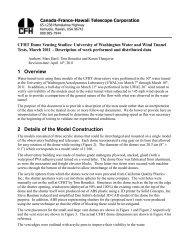ALLEN BRADLEY 1747-L551 PLC Processor
ALLEN BRADLEY 1747-L551 PLC Processor
ALLEN BRADLEY 1747-L551 PLC Processor
Create successful ePaper yourself
Turn your PDF publications into a flip-book with our unique Google optimized e-Paper software.
A–2 Setting Up the DH-485 Network<br />
DH-485 Token Rotation<br />
A node holding the token can send any valid packet onto the<br />
network. Each node is allowed only one transmission (plus two<br />
retries) each time it receives the token. After a node sends one<br />
message packet, it attempts to give the token to its successor by<br />
sending a “token pass” packet to its successor.<br />
If no network activity occurs, the initiator sends the token pass<br />
packet again. After two retries (a total of three tries) the initiator will<br />
attempt to find a new successor.<br />
Important: The maximum address that the initiator will search for<br />
before wrapping to zero is the value in the configurable<br />
parameter “maximum node address.” The default value<br />
for this parameter is 31 for all initiators and responders.<br />
The allowable range of the node address of an initiator is 0 to 31.<br />
The allowable address range for all responders is 1 to 31. There<br />
must be at least one initiator on the network.<br />
DH-485 Network<br />
Initialization<br />
Network initialization begins when a period of inactivity exceeding<br />
the time of a link dead timeout is detected by an initiator on the<br />
network. When the time for a link dead timeout is exceeded, usually<br />
the initiator with the lowest address claims the token. When an<br />
initiator has the token it will begin to build the network. The<br />
network requires at least one initiator to initialize it.<br />
Building a network begins when the initiator that claimed the token<br />
tries to pass the token to the successor node. If the attempt to pass<br />
the token fails, or if the initiator has no established successor (for<br />
example, when it powers up), it begins a linear search for a successor<br />
starting with the node above it in the addressing.<br />
When the initiator finds another active initiator, it passes the token to<br />
that node, which repeats the process until the token is passed all the<br />
way around the network to the first node. At this point, the network<br />
is in a state of normal operation.<br />
Devices that use the<br />
DH-485 Network<br />
Presently, the following SLC 500 devices support the DH-485<br />
network:<br />
• SLC 500 Fixed I/O Controller (responder)<br />
• SLC 5/01 Modular I/O Controller (responder)<br />
• SLC 5/02 Modular I/O Controller (initiator/responder)<br />
• SLC 5/03 Modular I/O Controller (initiator/responder)<br />
• SLC 5/04 Modular I/O Controller (initiator/responder)<br />
• SLC 5/05 Modular I/O Controller (initiator/responder)<br />
• Personal computer running your programming software (initiator)<br />
• Hand-Held Terminal (initiator)<br />
• DTAM (initiator/responder)<br />
Publication <strong>1747</strong>-6.2




![Documentation [PDF] - Canada France Hawaii Telescope ...](https://img.yumpu.com/26965302/1/190x245/documentation-pdf-canada-france-hawaii-telescope-.jpg?quality=85)







